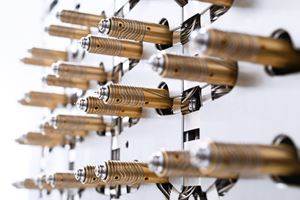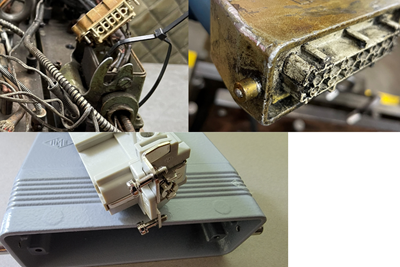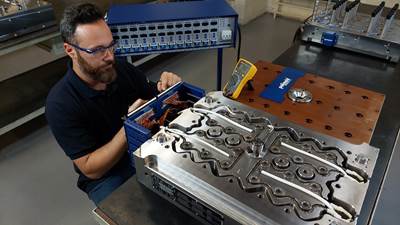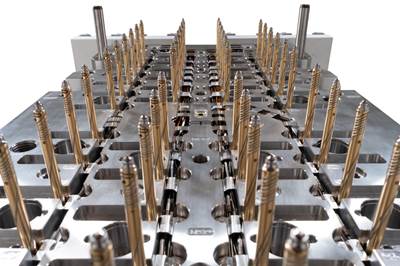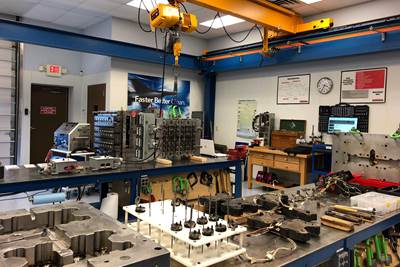Hot Runner Systems
A hot runner system is an assembly of heated components used in plastic injection molds that inject molten plastic directly into the cavities of the mold. Unlike cold runner systems, hot runner systems do not require sprue and runner systems. They are feed systems that convey molten plastic from the machine nozzle into the cavity. It uses a heated manifold to keep that plastic in a molten state. The heated plastic travels from the molding machine nozzle through internal channels called “hot runners” and can be delivered into multiple cavities at the same time. The only component that needs to be removed each cycle is the part itself, ensuring the mold can be cycled again very quickly. The increased cycle time and reduced plastic waste is ideal for high-volume production. Hot runners can inject plastic directly into the part cavity, which is how they differ from cold runner systems. They are also larger and more complex than cold runners which results in longer setup times and increased installation costs. Hot runner systems consist of the following components: Nozzle body (also known as the drop) The link to the cavity. They are either directly gated into the part, or into the sub runner, which will lead into the cavity. Valve gate pin is dropped through this part There four style categories available: Threaded nozzles Support ring nozzles Single valve gate nozzles Sprue Bushings Manifolds Flow control Controls the melt flow in the form of valve gate nozzles or even control systems Connections Hot halves

ESSENTIAL READING
VIEW ALLHow to Use Hot Runner Balance in Mold Qualification
If you are interested in the impact of system and hot runner balance on part quality, the causes of unbalanced hot runner systems and short shot parts, the procedure for measuring system balance and the impact of application specifics on system and hot runner balance expectations, then tune into this on-demand webinar.
Read MoreRevisiting Some Hot Runner Fundamentals
What exactly does a hot runner do? If you’ve been in the injection molding industry for any length of time, you might think the answer is obvious, but it is not.
Read MoreHow to Overcome Five Common Hot Runner Cable Connection Problems
Here are some simple solutions for pushed-back or bent pins, pushed-back inserts, high amp deterioration, loose or broken latches and missing or loose ground wire connections.
Read More5 Hot Runner Tips for Moldmakers and Molders
Best practices for initial hot runner tryouts and effective preventive maintenance.
Read MoreHow to Solve Hot Runner Challenges When Molding with Bioresins
A review of the considerations and adaptations required to design hot runners and implement highly productive injection molding operations.
Read MoreWhat You Need to Know About Hot Runner Systems and How to Optimize Their Performance
How to make the most out of the hot runner design, function and performance.
Read MoreLatest Hot Runners News And Updates
2024 Moldmaking Insights: A Year in Review Part 1
A look back at the top moldmaking trends of 2024, as revealed through MMT's analytics. This review highlights the most popular technical articles, case studies, tips and best practices that captured the industry's attention over the past year.
Read MoreRecent Innovations in Mold Components and Hot Runners
In this most recent product roundup, MMT continues to offer a variety of innovative as well as tried-and-true technologies to benefit moldmakers.
Read MoreValve Gate Products for Technical Applications
Oerlikon HRSflow has developed new external valve gate end rings for the Tp and Vp nozzle series. The company also introduces its Through The Cavity (TTC) end ring for Tp nozzles.
Read MoreVIDEO: Sustainable Molding and Advanced Gating
Hot runner supplier emphasizes sustainability in bio-resin molding, custom side gating and valve gate technologies.
WatchVIDEO: Hot Runner Systems and Motion Control Advancements
Innovations in hot runner and mold motion controller technologies contribute to a more sustainable manufacturing process.
WatchHoning System Enhances Precision of Hot Runners in Injection Molding
Microcut AG highlights its Swiss honing systems for the fine machining of bores in mold manufacturing. The system assists hot runner systems for injection molding.
Read MoreFeatured Posts
Revisiting Some Hot Runner Fundamentals
What exactly does a hot runner do? If you’ve been in the injection molding industry for any length of time, you might think the answer is obvious, but it is not.
Read MoreHow to Overcome Five Common Hot Runner Cable Connection Problems
Here are some simple solutions for pushed-back or bent pins, pushed-back inserts, high amp deterioration, loose or broken latches and missing or loose ground wire connections.
Read MoreVIDEO: Mold Component Advancements & Hot Runner Insights
Advancements in mold components, hot runner temperature control and custom manifold configuration that address cycle time, quality and sustainability issues.
Watch5 Hot Runner Tips for Moldmakers and Molders
Best practices for initial hot runner tryouts and effective preventive maintenance.
Read MoreHow to Solve Hot Runner Challenges When Molding with Bioresins
A review of the considerations and adaptations required to design hot runners and implement highly productive injection molding operations.
Read MoreTechnology Review and Sourcing Guide 2024: Hot Runners
A hot runner system is an assembly of heated components used in plastic injection molds that inject molten plastic directly into the cavities of the mold. Access exclusive, online-only content, including a suppliers list, hot runner products as well as services.
Read MoreFAQ: Hot Runners
What are the different types of hot runner systems?
- Hot tip: Standard, general-purpose version. Considered to be more economical than valve gates and is ideal for mass production of simple parts and products
- Valve gate: Features a mechanical valve that automatically closes when the machine injects plastic into the mold, resulting in a smooth enclosure and no visible surface abrasions on the product. Ideal for highly aesthetic projects. More efficient, but more expensive as a result
What are hot runner systems typically used for?
- Cell phone cases
- Bottle caps
- Projects that require a high volume of inexpensive parts
- Other high-volume items
What are the advantages of hot runner systems?
- Elimination of the runner: helps with cost, etc.
- Cycle time reduction/lower processing cost
- Improved molding system efficiency: No need to remove solidified plastic, etc.
- Optimal part quality
- Molding automation: can continue running
- Design flexibility
- Balanced melt flow: Melt channels are in separate, heated manifolds (same distance being filled)
What should moldmakers consider when purchasing a hot runner system?
Evaluating the cost justification for a hot runner mold requires careful consideration of cycle time, material type, annual volume, available press size and power consumption, as well as the cost of utilities, resin pricing, allowable regrind percentage and labor rates. Here are three key areas to consider:
1. Cold Vs. Hot Process Considerations
Cycle time is the primary cost measure of the molding process, and cooling represents about 80% of the molding cycle. The thicker the part, the longer the cycle time. However, the runner could determine the cooling time, and increase cycle time more than expected if the runner is thicker than the part.
The minute the resin leaves the machine barrel, the material starts to cool and solidify. This, in turn, causes injection pressures to climb and can yield unfilled parts, stress and warp. Limit the l/t ratio (length of flow versus part thickness) to avoid this outcome. Generally, a ratio under 100 is considered general-purpose molding and does not require increased injection pressures.
In a cold runner mold, the l/t ratio is measured from the start of the cold sprue, where the material leaves the heat source and begins to cool, which continues through the entire runner to the furthest point in the part (last point of fill). For example, 1 mm (0.039 inch) thick resin can flow easily 100 mm (3.94 inch). However, if a hot runner is used, the l/t ratio starts at the gate, reducing flow length and the injection pressure required to fill the part.
The higher the ratio, the more injection pressure is required to fill the part. A cold runner is included in the l/t calculation when the molder measures at the point of no added heat. This is one reason hot runners are appealing and can make the difference between molding a good or bad part.
2. Material Considerations
Most polyolefin resins can be reused without issue. Engineered materials can be limited in regrind content because each time the resin is processed, it experiences another heat history that can degrade melt quality and impact performance, color, rigidity, tensile strength, etc.
Keep in mind, not every runner makes it to the granulator, and not every pellet makes it back to the hopper. While eliminating the cold runner can reduce scrap, a complete hot runner system might not be cost-justified based on low annual volume. The cost of an entire hot runner system may take longer than a year for payback. It might be wise to consider a hot/cold combination or at least a heated sprue bushing. The sprue is typically the thicker portion of the runner, and eliminating that and/or a portion of the runner could have an impact on the cycle time, resin consumption, scrap, etc.
In some applications, a hot runner system might eliminate scrap from unusable runners, but based on the required shot size volume (total volume of parts and runners) relative to the barrel volume, and it might reduce the consumption causing the barrel of the molding machine to be too large. Residence time on engineered materials would increase, which may cause other issues. For example, too small a shot can be challenging to process even with olefins.
3. Energy Considerations
Hot runner systems run on electricity like granulators. An injection molding machine takes roughly 1 kiloWatt (kW) to process 1 kg (454 lbs) of resin. Reducing the shot size to parts only can have a significant impact on power consumption. It stands to reason that only heating, melting and processing parts takes less energy than parts and runners.
When deciding between a cold or hot runner system, consider all of these variables, which combined can increase productivity and energy savings, improve material utilization and reduce floor space and noise requirements on the shop floor.



